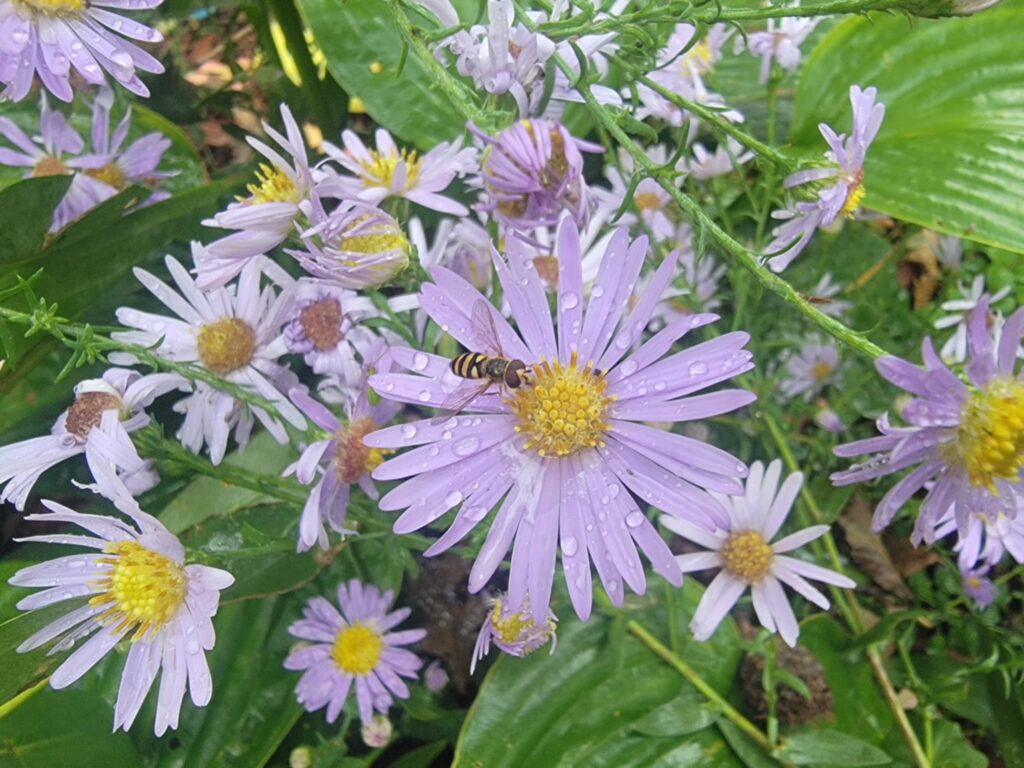Katie Byerly of Cerro Gordo County—also known as Iowa Prairie Girl on YouTube—loves the colorful world of wildflowers. Have you ever noticed that while some flowers sport a variety of fun nicknames, others seem to have none at all? Old farmers, for example, know marsh marigolds as “cowslips.” Soapwort is also called “Bouncing Bet.” Then there’s common mullein, which has a whole list of quirky names: cowboy toilet paper, flannel leaf, Quaker’s rouge, and Aaron’s rod, just to name a few.
On the other hand, some wildflowers, like asters and goldenrod, have very few nicknames. Perhaps that’s because both wildflowers come in so many varieties, making them hard to tell apart. I imagine our forefathers may have felt the same way I do—“another #%! aster.” Even wildflower expert Sylvan Runkel didn’t attempt to recognize all the different asters and goldenrods in either of his books, *Wildflowers of the Tallgrass Prairie* or *Wildflowers of the Iowa Woodlands*.
But I have good news—one aster is easy to identify!
### The Easy-to-Spot Aster
Similar to stiff goldenrod, Smooth Blue Aster has an easy tell: its smooth, clasping, light green-blue leaves. A clasping leaf is one that wraps around the plant’s stem at its base. The smooth blue aster’s hairless leaves grow alternately along its equally smooth, hairless stem. The waxy leaves are a dull grayish-green or blue, and water beads on them, highlighting just how waxy they are. These oblong or long-oval leaves gradually become smaller towards the top of the plant, and their edges are smooth and toothless. The underside of the leaves is a lighter green, with visible veins.
In full sun, Smooth Blue Aster stands erect. In partial shade or when heavy with flowers, the plant may droop a bit from the weight or lack of sunlight.
### Stunning Blooms for Garden and Pollinators
Beautiful, loose, branching clusters of flowers top the plant, with smaller clusters along the stems below. These cheerful, bright panicles are made up of light lavender or light blue-violet flowerheads. Each flower is about ½ to 1 inch across, with 15–30 ray petals. The vibrant shape of the flower gives the aster one of its few common names. “Aster” is a Greek word meaning “star”—a nod to the star-like shape of the flower and its bracts. That’s where nicknames like “starwort” or “starflower” come from.
At the heart of each bloom is a center of densely packed disk florets, which start out yellow and gradually turn a burnt red as the flower matures.
### Identifying Features to Look For
Plant identification often involves looking at the back of the flower, at the bracts or “phyllaries” surrounding the base. On a Smooth Blue Aster, you’ll find 4–6 layers of phyllaries, each ending in a diamond-shaped tip with a red dot. Here is an image of the Smooth Blue Aster bracts/phyllaries for easy reference. (Honestly, if I’m down to counting bracts, I may just say “another #%! aster!”)
A sure way to get familiar with asters is to grow them yourself. All the Smooth Blue Aster photos in this post are from plants I grew in my own yard last summer. I purchased them from SuperFresh Garden Store in Austin, Minnesota. SuperFresh sells native wildflower plants started from seeds purchased from Prairie Moon Nursery in Winona, Minnesota.
### Frostflowers, Bees, and Butterflies
“Frostflowers” is another rare nickname for asters, referring to their late blooming season. My Smooth Blue Asters bloomed in September, providing a lovely fall bouquet and a late-summer treat for pollinators. Throughout the month, there wasn’t a day when bees weren’t visiting my asters.
Smooth Blue Aster is also the host plant for Pearl Crescents and Silvery Checkerspot butterflies. Although I never saw either of these butterflies on my asters, many Pearl Crescents did visit my yard. (Here’s an image of a Pearl Crescent on a zinnia!)
As of today—October 28—a few blooms remain on my plants. The spent flower heads have turned into dry, light brown seed tufts, ready to be carried off by the wind or (hopefully) fall to the ground and expand my aster plot for next year.
—
*Author: Katie Byerly (Iowa Prairie Girl)*
https://www.bleedingheartland.com/2025/11/05/iowa-wildflower-wednesday-smooth-blue-aster/

